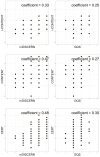Analysis of YouTube-Based Therapeutic Content for Children with Cerebral Palsy
- PMID: 39062263
- PMCID: PMC11276610
- DOI: 10.3390/children11070814
Analysis of YouTube-Based Therapeutic Content for Children with Cerebral Palsy
Abstract
Background/objectives: Cerebral palsy (CP) causes movement and posture challenges due to central nervous system damage, requiring lifelong management. During the COVID-19 pandemic, there was limited access to facility-based treatments, which increased the demand for home-based therapies and digital resources. We analyzed the qualitative and quantitative aspects of YouTube videos focusing on CP therapy for children.
Methods: A total of 95 videos were evaluated for content quality using the modified DISCERN (mDISCERN) tool and Global Quality Scale (GQS). The therapeutic program efficacy was assessed via the International Consensus on Therapeutic Exercise and Training (i-CONTENT) tool, Consensus on Therapeutic Exercise Training (CONTENT) scale, and Consensus on Exercise Reporting Template (CERT), and popularity was measured by the video power index (VPI).
Results: YouTube-based therapeutic videos for children with CP generally exhibit reliability in video content and effectiveness in therapeutic programming, and no correlations were found between video popularity and quality. However, the qualitative analysis reveals insufficient mention of uncertainty in the treatment principles within the video content as well as a lack of detailed treatment descriptions encompassing aspects such as intensity, frequency, timing, setting, outcome measurement during and post-treatment, and safety considerations within therapeutic programs. In particular, this tendency was consistent regardless of the uploader's expertise level and the classification of the neuromotor therapy type in contrast to that of the exercise type.
Conclusions: YouTube-based content for CP children still has significant limitations in how substantive viewers, such as caregivers, can acquire tailored information and apply practical information to their exercise and treatment programs.
Keywords: YouTube; cerebral palsy; exercise; neuromotor therapy; quality; video.
Conflict of interest statement
The authors declare no conflicts of interest.
Figures




Similar articles
-
Quality Analysis of YouTube-Based Exercise Programs for Typically Developing Children: Content Analysis.Healthcare (Basel). 2025 Mar 5;13(5):560. doi: 10.3390/healthcare13050560. Healthcare (Basel). 2025. PMID: 40077122 Free PMC article.
-
Quality of online video resources concerning patient education for neck pain: A YouTube-based quality-control study.Front Public Health. 2022 Sep 21;10:972348. doi: 10.3389/fpubh.2022.972348. eCollection 2022. Front Public Health. 2022. PMID: 36211682 Free PMC article.
-
Assessment of the quality and reliability of the information on spasticity on youtube.J Clin Neurosci. 2023 Jul;113:142-146. doi: 10.1016/j.jocn.2023.05.018. Epub 2023 Jun 1. J Clin Neurosci. 2023. PMID: 37269749
-
Review of the Quality of YouTube Videos Recommending Exercises for the COVID-19 Lockdown.Int J Environ Res Public Health. 2022 Jun 30;19(13):8016. doi: 10.3390/ijerph19138016. Int J Environ Res Public Health. 2022. PMID: 35805674 Free PMC article. Review.
-
YouTube as a Source of Information on Lipedema: Property, Quality, and Reliability Assessment.Lymphat Res Biol. 2023 Aug;21(4):403-409. doi: 10.1089/lrb.2022.0028. Epub 2023 Mar 16. Lymphat Res Biol. 2023. PMID: 36927077 Review.
References
-
- Bonanno M., Militi A., La Fauci Belponer F., De Luca R., Leonetti D., Quartarone A., Ciancarelli I., Morone G., Calabrò R.S. Rehabilitation of Gait and Balance in Cerebral Palsy: A Scoping Review on the Use of Robotics with Biomechanical Implications. J. Clin. Med. 2023;12:3278. doi: 10.3390/jcm12093278. - DOI - PMC - PubMed
-
- Nguyen H.B., Mulpuri N., Cook D., Greenberg M., Shrader M.W., Sanborn R., Mulpuri K., Shore B.J. The Impact of COVID-19 on Multidisciplinary Care Delivery to Children with Cerebral Palsy and Other Neuromuscular Complex Chronic Conditions. Children. 2023;10:1555. doi: 10.3390/children10091555. - DOI - PMC - PubMed
LinkOut - more resources
Full Text Sources
Miscellaneous

